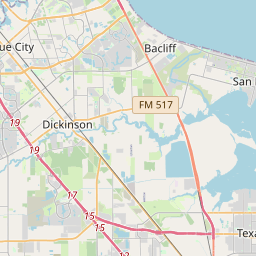St. George's Episcopal Church
Historical marker location:






St. George's Episcopal Church
The first Episcopal worship service in Texas City took place on March 23, 1913, two years after the city incorporated and the same year the United States Army arrived as part of its coastal defense of American interests during the Mexican Revolution. The Rev. C. W. Freeland, chaplain to the 6th Cavalry stationed in Texas City at the time, presided at the Easter Day service. That summer, the Rt. Rev. George H. Kinsolving, Bishop of Texas, organized the new congregation as a mission to be known as St. George's.
Worship services were held in the homes of members until the spring of 1915. In that year, St. George's purchased and moved an Army recreation building to its new property at 314 10th Avenue North. Despite the destruction of its first church building in the 1915 Hurricane, the first recorded baptisms were held in September 1915, and Bishop Kinsolving confirmed the seven members in the first confirmation class in 1917. A new frame chapel, built on property at 10th Avenue and 4th Street, was completed about 1923.
In 1940, St. George's became self-supporting and moved from mission to parish status. Within the next decade, the congregation experienced World War II, the 1947 Texas City explosion and the beginnings of a booming city economy. During the 1950s, the growing congregation constructed a new church building at this site, a rectory a few blocks east, a classroom and office wing, and a parish hall. Hurricane Carla in 1961 and a disastrous fire in 1983 caused much damage to the facilities, but the members of the congregation persevered to continue their mission and a variety of ministries, including worship, education, and community outreach, into the 21st century.
(2003)
As one of the most visible programs of the Texas Historical Commission (THC), historical markers commemorate diverse topics in Texas history, including: the history and architecture of houses, commercial and public buildings, religious congregations, and military sites; events that changed the course of local and state history; and individuals who have made lasting contributions to the state, community organizations, and businesses.
The Battle of San Jacinto fought on April 21, 1836, was the decisive battle of the Texas Revolution, and led to the capture of Santa Anna and the end of the conflict.
In 1816, Pirate Jean Lafitte established a short-lived settlement on Galveston Island, which became a haven for smugglers and criminals. However, the pirate era came to an end when the Mexican government took control of Texas and drove out Lafitte and his fellow pirates.
The 19th century saw Galveston County become a major seaport and commercial center. In 1839, the city of Galveston was founded and quickly grew in size and prosperity. The city became an important hub for the Texas cotton industry and played a significant role in the Texas Revolution and the Civil War.
However, Galveston faced numerous challenges throughout its history, including devastating hurricanes. The most notable was the Great Storm of 1900, which remains the deadliest natural disaster in U.S. history, claiming thousands of lives and causing extensive damage. Despite the destruction, Galveston rebuilt and implemented engineering projects, including the construction of a seawall, to protect the city from future hurricanes.
Today, Galveston County is a popular tourist destination, known for its beautiful beaches, historic architecture, and vibrant cultural scene. The county has successfully preserved its rich heritage while embracing modern development, making it a unique and diverse place to visit and live.
Galveston County Timeline
This timeline provides a glimpse into the major events and milestones that have shaped the history of Galveston County, Texas.
- 1528 - Spanish explorer Cabeza de Vaca becomes the first known European to set foot on Galveston Island
- 1816 - Pirate Jean Lafitte establishes a base on Galveston Island
- 1825 - Galveston becomes a port of entry for the newly formed Republic of Mexico
- 1836 - Galveston becomes an important port during the Texas Revolution
- 1839 - The City of Galveston is officially incorporated
- 1854 - Galveston becomes the largest city in Texas
- 1900 - Galveston is struck by a devastating hurricane, resulting in over 6,000 deaths
- 1901 - Oil is discovered in nearby Spindletop, leading to a period of economic growth
- 1957 - The world's first offshore drilling rig is built in Galveston
- 2008 - Hurricane Ike causes significant damage to Galveston